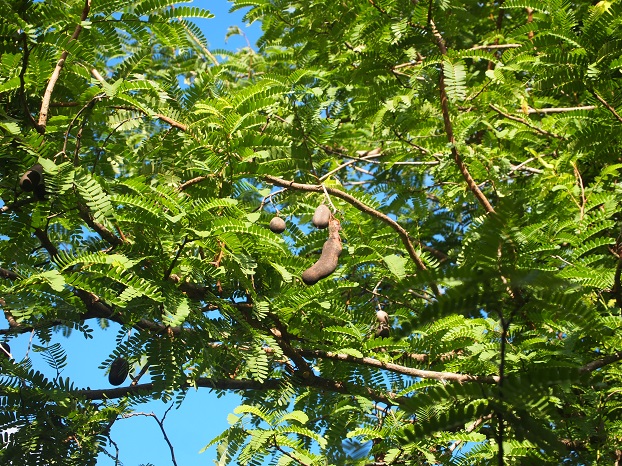
The tamarind tree was a fixture in our summer vacation road trips a long, long time ago. As our car sped down the two-lane highway winding through the rural areas between two cities, we’d yell for a stop. Just to stretch our legs, we’d say. With nary a coffee shop in sight, with the destination still hours away, our parents would hem and haw, but the kids would usually have their way.
Rest stops, however frequent, were a welcome occurrence on Indian road trips. As the adults stretched and checked to make sure the radiator hadn’t overheated, the kids got busy with sticks and stones, trying to knock down tamarind from the roadside trees we’d spied from the car or gather the good ones that had fallen on the ground.
Can you imagine tamarind just growing by the roadside? We’d often find farmers and villagers waiting for a bus, perhaps, or just taking refuge in the ample shade of the trees’ majestic canopies. The fruit would be sour during our summer road trips or the trees would be bare because they’d have been harvested as soon as the fruits showed signs of ripening.
We’d squirrel away some of the tamarind until we could get to some salt and red chili powder to dip them in, but the rest of it was fair game for immediate consumption. Peeling the tough outer layers of the tamarind, carefully stripping away the tough fiber and getting to the scant amount of green or brown fruit that wraps itself around shiny, walnut brown seeds — it’s one of those memories that drives you to reenact the entire scene the minute you find yourself in the same circumstances again.
We’d save up the seeds to play with in board games (Alli Gulli Mané, the Indian version of Mancala). By the time we were ready to get back in the car the adults would be smacking their lips and scrunching up their faces just as hard as us because of the sourness of the raw fruits.
A Cornerstone Flavor Of South Indian Cooking
The flavor of tamarind — a fruity sourness — is a cornerstone of South Indian cooking. It’s more often than not paired with jaggery, especially in the cuisines of the northern part of Karnataka. Tamarind makes an appearance in South Indian staples such as rasam (a thin lentil soup), sambhar or dal (lentil and vegetable gravy), gojju (a condiment in which tamarind is the central ingredient and jaggery the able sidekick; it is served as an accompaniment to rice and rotis), chutneys and chutney powders.
Whenever I think of the tamarind and its role in a meal, I am reminded of a guitarist or a pianist, who as they are playing pieces in the center of their instruments, suddenly swoop down to the edge, to the bottom of the neck in the guitar or the edge of the piano keys, and strike a note that reverberates long after their fingers have gone back to the center. The tamarind is that note at the end — sharp, high pitched, with a taste that stays long after you’ve gone back to the somber breads or rice.
The flowers and leaves of the tamarind tree are also edible. In fact, my grand mom-in-law, Shakuntala Bai, had a recipe for tamarind flower chutney, which unfortunately I haven’t been able to make because I don’t know how to get them. (Raw tamarind is also hard to come by in non-tropical countries.) Her home had a tamarind tree in the back yard and my mother-in-law recounts stories of plucking the flowers from the trees and getting them straight into the kitchen.
Every part of the tamarind tree has some use — the fruit, flowers and leaves for cooking, the trunk for woodwork, the seeds for board games, and the pulpy remains of the fruit (once all the juice has been removed for cooking) for scrubbing and shining metal kitchen implements and brass lamps and statues.
Where To Buy And How To Use
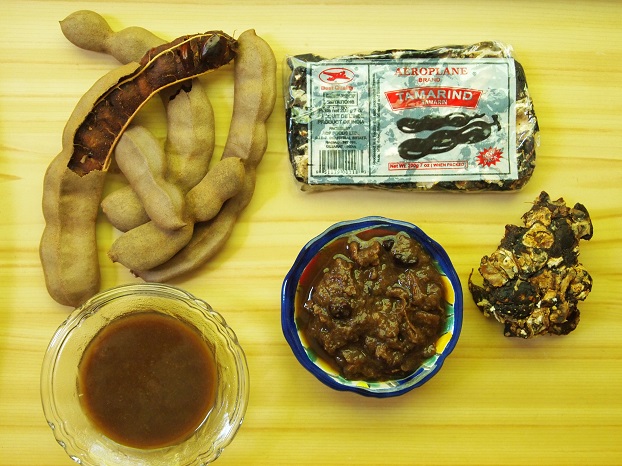
An Indian or general Asian grocery store is the best place to find tamarind. The tamarind fruit is peeled and pressed together into rectangular slabs. It will need to be cleaned before being used. Pluck any stray outer coverings (they’ll be tough to the touch) and thick fiber still stuck in the fruit. Be careful to remove all remaining seeds. Once cleaned, soak the required amount of tamarind in warm water and let it sit for a while. The warm water softens up the tamarind and makes it easy for you to squeeze out the juice. Most recipes using tamarind call for its juice obtained this way; some just require tamarind straight out of the slab, cleaned.
At the beginning it might be difficult to assess the exact measurement of the juice because the intensity of the flavor depends on how much water was used and how much juice was extracted out of the pulp. But once you do this a couple of times, it’ll be easy to adjust the intensity to suit your taste. As with any spice, start small and add on as necessary; it’s always easier to add than to subtract.
Tamarind paste, which is a ground concentrate of the fruit, is also available in grocery stores but for Indian dishes it’s almost always better to use tamarind soaked as above rather than the paste because the paste tends to impart too intense a flavor to the dish overwhelming all others.
Recipes
The following recipe for Tomato Dal is from my mom-in-law’s family, a dish that already gets some of its sourness from tomatoes, but showcases the tamarind’s unique brand of sourness which enhances the flavor tremendously.
Dishes made of Moong Dal (split green gram) and Toor Dal (split pigeon peas) are fixtures in the two main meals of the day — lunch and dinner. The dals are also used to make fried savory snacks. Dal recipes range from very simple ones such as this Tomato Dal to complex ones such as sambhars with many ingredients and many layers of prep. Packed with protein, lightly salted boiled dal with ghee and rice forms the first solid food fed to many young children in South India.
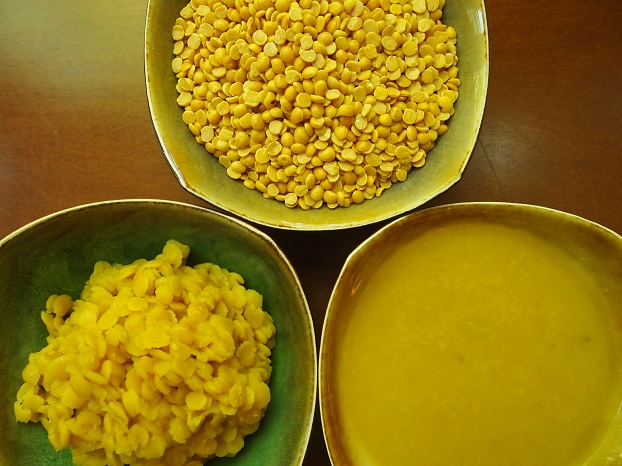
Tomato Dal’s base is Toor Dal or split pigeon peas and tomatoes. The dal is yellow in color and has been grown for a few thousand years. Toor Dal is available in Indian grocery stores. See the notes below the recipe for instructions on how to boil Toor Dal. For the tomatoes in the recipe pick ripe, flavorful Roma plum or vine-ripened tomatoes.
Fenugreek seeds are available in powdered form and as seeds. It’s all right to use readymade fenugreek seed powder, but it’s ideal to dry roast a small amount of seeds in a small heavy-bottomed pan (stir constantly so it doesn’t burn) to a dark golden color and then grind them in a spice mill. The freshness does improve the flavor of the dish.
I’ve also included a recipe for Baby Radish Raita, which complements the Tomato Dal perfectly. Here I’ve used baby radish, which is softer and much less pungent than the long white radish usually found in this raita.
Serve the dal and the raita with naan, chapatti (available frozen in Indian grocery stores) or other types of flat bread, or steamed rice.
Tomato Dal
Makes 6–8 servings
Tempering Ingredients:
2 tbsp oil
1 tsp mustard seeds
¼ tsp asafetida
¼ tsp turmeric powder
5 + 5 curry leaves
Tomato Dal Ingredients:
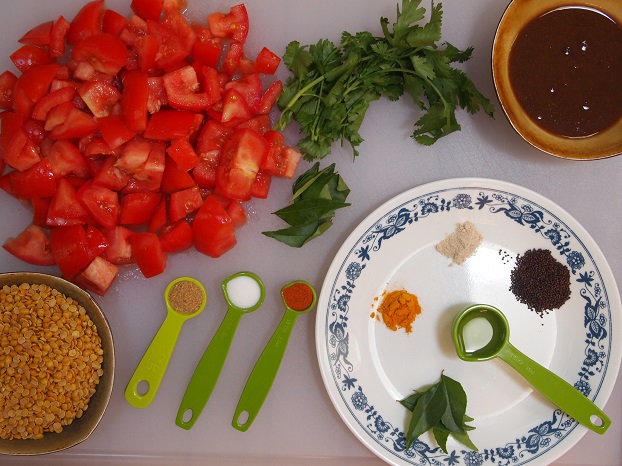
1 cup toor dal (split pigeon peas), cooked in a pressure cooker with ¼ tsp turmeric and a few drops of oil, until soft (see note below for instructions) to yield about 3 cups
6 ripe tomatoes, chopped coarsely, about 3½ cups
¼ cup tamarind juice
Salt to taste (about 1 tsp — start low and add, to taste, up to 1 tsp)
½ tsp chili powder
½ tsp roasted methi (fenugreek) seed powder
2 tbsp chopped coriander leaves
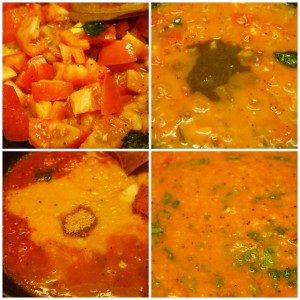
Method:
In a large heavy saucepan, heat the oil to shimmering and add the mustard seeds. Lower the flame to medium. Watch for the mustard seeds splattering. They have an unerring aim and will burn your eyes. Keep a plate handy to cover the pan. When the mustard seeds stop crackling, add asafetida, turmeric powder and half of the curry leaves. Sauté for about 20 seconds.
Add tomatoes and sauté until soft, about four minutes. With your spatula, break down any large chunks of tomato and stir. Add the tamarind juice and bring to a boil. Add the cooked toor dal, salt, chilli powder and methi powder, stir to blend all the ingredients and cook gently on a low flame for about seven minutes. Do a quick taste test and adjust salt and chili powder.
As it is boiling, add the coriander leaves and the rest of the curry leaves. Add a handful of water, if necessary. The consistency must be thick. Transfer to a serving bowl.
Serve with hot rice, chapattis and rotis.
Note:
A pressure cooker is ideal to boil toor dal. Usually a cup of toor dal takes about 1 ½ to 2 cups of water. If you don’t have a pressure cooker, place the toor dal and water in a large saucepan, bring to a roiling boil over high heat, lower the flame, cover and let cook. If you notice the water level falling to below the dal, add more, raise the heat and bring to a boil again. The dal is done cooking when you can smush it completely with two fingers (you will see the lentils cracking at the edges). Add a bit of warm water and whisk the dal until it is smooth and the individual lentils are no longer visible.
Baby Radish Raita
Makes 4–6 servings
Baby Radish Raita Ingredients:
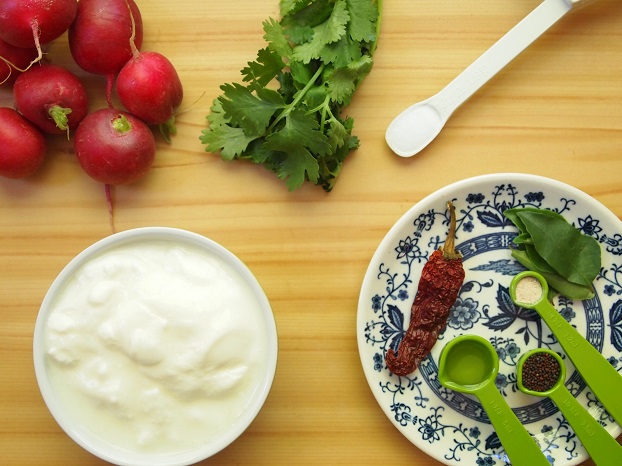
1 cup plain low fat yogurt
1 bunch baby radish, stems trimmed and grated; yield about 2/3 cups
Salt to taste (about ½ to ¾ tsp)
2 tbsp chopped coriander leaves
Tempering Ingredients:
1 tsp oil
½ tsp mustard
¼ tsp asafetida
1 dry red chili, stem removed and split in two (optional)
4 curry leaves
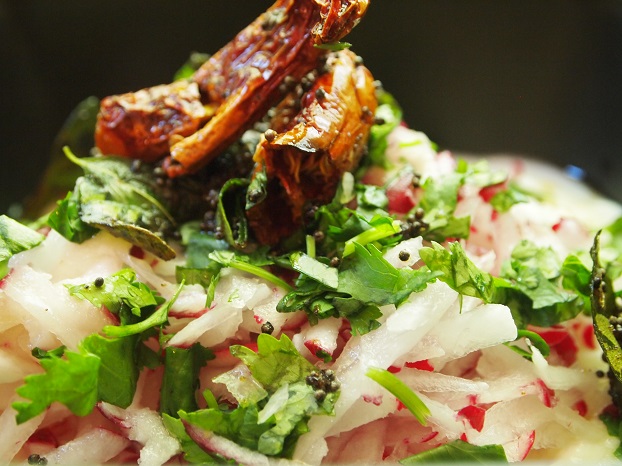
Method:
In a medium bowl, gently mix together the yogurt, grated baby radish, and salt. If it is too thick, add a few tablespoons of water to loosen. Note that the salt will draw the moisture out from the yogurt and the radish, so if you wait for a few minutes after you add the salt, you might find that the consistency is not too thick after all.
In a small, heavy saucepan, heat the oil to shimmering and add the mustard seeds. When the mustard seeds stop crackling, add asafetida, dry red chili and curry leaves. Sauté the mixture for about 20 seconds. Remove from the stove and add to the yogurt and baby radish mixture in the bowl. Mix gently, adjust salt. Garnish with the chopped coriander leaves and serve.
If you are feeling brave and up for an adventure, crush a little bit of the red chili into the raita and try it. If you are not a big fan of spicy heat, remove the red chili pieces before serving.
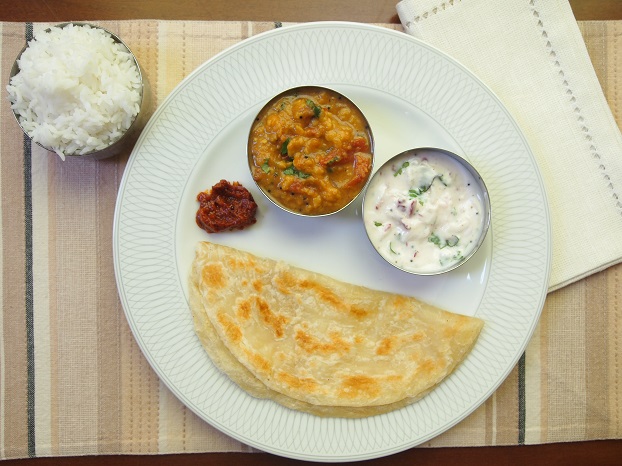
* * *
Sujatha Bagal is a Washington, D.C.- based freelance writer and blogger. Her essays, articles and stories have appeared in various online and print publications, including Pregnancy, Mint Lounge, ForbesLife India and The Smart Set (links available here). Find her onTwitter and Instagram. She is currently working with her mom-in-law, Kalindi Jagirdar Bagal, on a cookbook featuring regional Karnataka cuisine.













Sujatha, I loved your potato and onion curry recipe. I’m thrilled to see a new post. Thank you for sharing your childhood memories and your cooking expertise.
Sherrill, so glad you made the potato curry. I’m delighted to be able to share the recipes! Do let me know if you have questions.